Sony VPL-DX140, DX120, VPL-DW120, DX100 User Manual

4-432-154-12 (1)
Data
Projector
Operating Instructions
Before operating the unit, please read this manual and supplied Quick Reference Manual thoroughly and retain it for future reference.
VPL-DX140/DX120/DX100
VPL-DW120
Not all models are available in all countries and area. Please check with your local Sony Authorized Dealer.
© 2012 Sony Corporation

Table of Contents |
|
Overview |
|
Location and Function of Controls .... |
3 |
Main Unit ..................................... |
3 |
Connector Panel ........................... |
4 |
Remote Commander and Control |
|
Panel Keys ................................. |
5 |
Preparation |
|
Connecting the Projector ................... |
7 |
Connecting a Computer ................ |
7 |
Connecting a Video equipment .... |
8 |
Projecting/Adjusting an |
|
Image |
|
Projecting an Image ........................... |
9 |
Adjusting the Projected image ... |
10 |
Turning Off the Power ................ |
13 |
Adjustments and Settings |
|
Using a Menu |
|
Using a MENU ................................ |
14 |
The Picture Menu ............................. |
15 |
The Screen Menu ............................. |
16 |
The Function Menu .......................... |
20 |
The Operation Menu ........................ |
21 |
The Connection/Power Menu .......... |
22 |
The Installation Menu ...................... |
23 |
The Information Menu ..................... |
24 |
Others |
|
Indicators .......................................... |
25 |
Messages List ................................... |
26 |
Troubleshooting ................................ |
27 |
Replacing the Lamp .......................... |
29 |
Cleaning the Air Filter ...................... |
31 |
Specifications ................................... |
32 |
Projection Distance ........................... |
37 |
Dimensions ....................................... |
42 |
Index ................................................. |
45 |
2 Table of Contents

B Overview
Location and Function of Controls
Main Unit
1
 2
2
5
 3
3
4
0
 6
6
7
8 9
a Focus ring (page 10) b Zoom ring (page 10) c Lens
d Remote control detector
e Foot adjust button (page 11)
f Front foot (adjustable) (page 11)
gAir filter cover/Ventilation holes (intake) (page 31)
h Lamp cover (page 29)
i Rear feet (adjustable) (page 11) j Ventilation holes (exhaust)
qk |
|
qj |
|
|
qa |
qh |
qs |
qg |
qd |
qf |
|
k Connector panel (page 4)
lSecurity bar
Connects to a commercially available security chain or wire.
mSecurity lock
Connects to an optional security cable manufactured by Kensington.
For details, visit Kensington’s web site. http://www.kensington.com/
n Control panel keys (page 5) o Ventilation holes (intake) p Speaker
qLAMP/COVER indicator (page 25)
rON/STANDBY indicator (page 25)
Caution
Do not place anything near the ventilation holes as this may cause internal heat buildup. Do not place your hand near the ventilation holes and the circumference as this may cause injury.
Overview
Location and Function of Controls |
3 |
|
|

Connector Panel
3 1 1
4


 3
3
Input (pages 7, 8)
aINPUT A
Video: RGB/YPBPR input connector Audio: Audio input connector
bINPUT B
Video: HDMI input connector Audio: HDMI input connector
2
cVIDEO
Video: Video input connector Audio: Audio input connector
Note
The audio inputs of INPUT A and VIDEO are shared.
Others
dAC IN ( ) socket
Connects the supplied AC power cord.
4 Location and Function of Controls
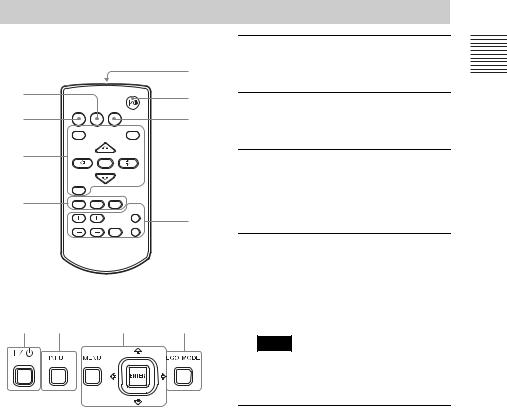
Remote Commander and Control Panel Keys
Remote Commander
4
INPUT |
APA |
ECO MODE |
|
2 |
|
|
|
MENU |
|
|
RESET |
3 |
ENTER |
|
|
|
|
||
RETURN |
|
|
|
ASPECT |
KEYSTONE |
PATTERN |
|
4 |
|
|
BLANK |
D ZOOM |
VOLUME |
FREEZE |
MUTING |
Control Panel Keys
1 2 3
|
a Turning on the power/Going to |
|
standby mode |
7 |
?/1 (On/Standby) key |
1 b Selecting an input signal
6(page 9)
INPUT key
c Operating a menu (page 14)
MENU key RESET key
ENTER /V/v/B/b (arrow) keys
RETURN key
5
dAdjusting the image (page 10)
ASPECT key (page 16) KEYSTONE key (page 12) PATTERN key (page 10)
APA (Auto Pixel Alignment) key*
6(page 12)
Note
* Use this key when inputting a computer signal via the RGB input connector (INPUT A).
eUsing various functions during projecting
D ZOOM (Digital Zoom) +/– key*1
Enlarges the image with the center of it as a starting point while projecting.
1Press the D ZOOM + key to display the digital zoom icon on the projected image.
2Press the D ZOOM + key or the D
ZOOM – key repeatedly to change the enlargement ratio. The image can be enlarged up to 4 times.
Press the RESET key to restore the previous image.
Overview
Location and Function of Controls |
5 |
|
|

BLANK key
Cuts off the projected image temporarily. Press again to restore the previous image. Picture muting helps reduce power consumption.
MUTING key
Mutes the audio output temporarily. Press again to restore the previous volume.
VOLUME +/– key
Adjusts the volume output.
FREEZE key*2
Pauses a projected image. Press again to restore the image.
Notes
*1: Use this key when inputting a computer signal. But it may not be used depending on the resolution of the input signal.
*2: Use this key when inputting a computer signal.
fSetting the energy–saving mode easily
ECO MODE key
Energy-saving mode can be set easily. Energy-saving mode consists of “Lamp Mode,” “With No Input,” and “With Static Signal.”
1Press the ECO MODE key to display the ECO Mode menu.
ECO Mode Menu
ECO Mode
ECO
User
:Sel |
RETURN :Back |
2Press the V/v key or ECO MODE key to select “ECO” or “User” mode. ECO: Sets each mode to the optimum
energy-saving value. Lamp Mode: Low With No Input: Standby
With Static Signal: Lamp Dimming
User: Sets each item of the ECO mode menu as you desire (go to step 3).
3Select “User” then press the b key. The setting items appear.
User
Lamp Mode |
|
High |
Auto Power Saving |
|
|
With No Input |
Off |
|
With Static Signal |
Lamp Dimming |
|
:Sel |
:Set |
RETURN :Back |
4Press the V/v key to select the item then press the ENTER key.
5Press the V/v key to select the setting value.
6Press the ENTER key.
The screen returns to the previous menu.
For details on ECO Mode settings, see “Lamp Mode”, “With No Input” and “With Static Signal” on the Connection/ Power menu (page 22).
Others
g Infrared transmitter
About remote commander operation
•Direct the remote commander toward the remote control detector.
•The shorter the distance between the remote commander and the projector is, the wider the angle within which the remote commander can control the projector becomes.
•Make sure that nothing obstructs the infrared beam between the remote commander and the remote control detector on the projector.
6 Location and Function of Controls
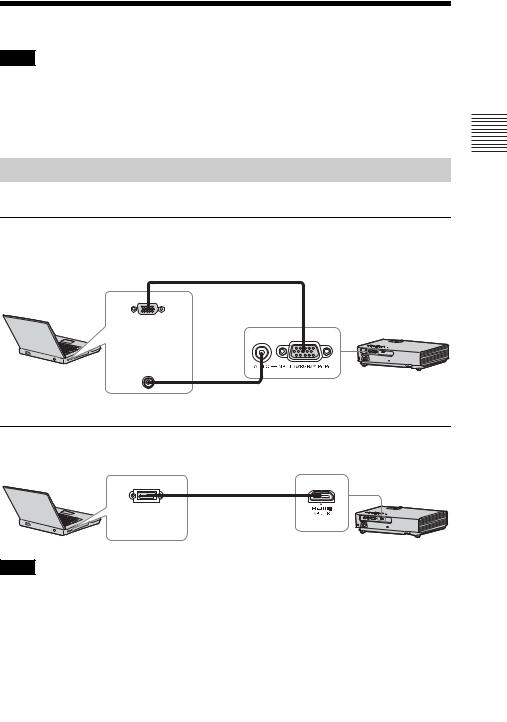
B Preparation
Connecting the Projector
Notes
•Make sure all the equipment is powered off when connecting the projector.
•Use the proper cables for each connection.
•Insert the cable plugs firmly; Loose connections may reduce performance of picture signals or cause a malfunction. When pulling out a cable, be sure to grip it by the plug, not the cable itself.
•For more information, refer also to the instruction manuals of the equipment you are connecting.
•Use a no-resistance audio cable.
Connecting a Computer
Connection with a computer is explained for each input signal.
INPUT A
For connecting a computer with an RGB output connector.
Mini D-sub 15-pin cable (supplied)
Preparation
RGB output connector
Audio output
connector
Computer
Audio cable (Stereo mini plug) (not supplied)
INPUT B
For connecting a computer with an HDMI output connector.
HDMI cable HDMI output (not supplied) connector
Computer
Notes
•Use HDMI-compatible equipment and cable(s) that have an HDMI logo on them.
•The HDMI connector of this projector is not compatible with DSD (Direct Stream Digital) Signal or CEC (Consumer Electronics Control) Signal.
•It is recommended that you set the resolution of your computer to 1024 × 768 pixels (VPL-DX140/ DX120/DX100) or 1280 × 800 pixels (VPL-DW120) for the external monitor.
Connecting the Projector |
7 |
|
|

Connecting a Video equipment
Connections with a DVD player or BD player are explained for each input signal.
VIDEO
For connecting video equipment with a video output connector.
Video cable (not supplied)
Video output connector
|
Audio output |
Video equipment |
connector |
|
Audio cable (Phono plug × 2 – stereo mini plug) (not supplied)
INPUT A
For connecting video equipment with a YPBPR output connector.
Component – Mini D-sub 15-pin cable (not supplied)
YPBPR output connector
|
Audio output |
Video equipment |
connector |
|
Audio cable (Phono plug × 2 – stereo mini plug) (not supplied)
INPUT B
For connecting video equipment with an HDMI output connector.
HDMI cable HDMI output (not supplied)
connector
Video equipment
Notes
•Use HDMI-compatible equipment and cable(s) that have an HDMI logo on them.
•The HDMI connector of this projector is not compatible with DSD (Direct Stream Digital) Signal or CEC (Consumer Electronics Control) Signal.
8 Connecting the Projector

B Projecting/Adjusting an Image
Projecting an Image
The size of a projected image depends on the distance between the projector and screen. Install the projector so that the projected image fits the screen size. For details on projection distances and projected image sizes, see “Projection Distance” (page 37).
Input
Video
Input-A
Input-B

 Sel
Sel
3 5
|
|
4 |
|
2 |
|
|
|
Video equipment |
Projector |
|
|
1 |
Wall outlet |
6 |
|
|
Computer |
1 Plug the AC power cord into the wall outlet.
2 Connect all equipment to the projector (page 7).
3 Press the ?/1 key to turn on the unit.
4 Turn on the connected equipment.
5 Select the input source.
Press the INPUT key on the projector to display the menu for switching input signal on the screen. Press the INPUT key repeatedly, or press the V/v key to select an image to be projected.
6 When projecting a computer image, switch your computer’s output to external display.
The method to switch the output varies depending on the type of computer.
(Example)
 +
+ 
7 Adjust the focus, size and position of the projected image (page 10).
Image an Projecting/Adjusting
Projecting an Image |
9 |
|
|
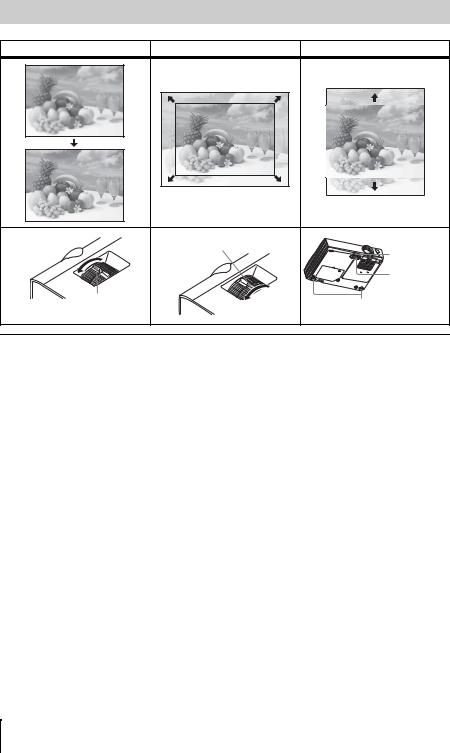
Adjusting the Projected image
Focus |
Size (Zoom) |
Position |
|
Zoom ring |
Foot adjust |
|
|
button |
|
|
Front foot |
|
|
(adjustable) |
Focus ring |
|
Rear feet |
|
|
|
|
|
(adjustable) |
Displaying a pattern for adjusting an image
You can display a pattern for adjusting the projected image with the PATTERN key on the remote commander. Press the PATTERN key again to restore the previous image.
10 Projecting an Image

Adjusting the tilt of the projector with the foot adjust button/rear feet (adjustable)
By changing the tilt of the projector with the foot adjust button/rear feet (adjustable), you can adjust the position of the projected image.
1Press and hold the foot adjust button, then lift up the front of the projector to adjust the angle.
2When the desired angle is achieved, release the foot adjust button to lock the position.
3Set the angle of the projector precisely by turning the rear feet (adjustable).
Notes
•Be careful not to let the projector down on your fingers.
•Do not push hard on the top of the projector with the front foot (adjustable) extended.
•Do not forcedly turn the rear feet (adjustable) more than they should be adjusted. Doing so may break them.
Changing the aspect ratio of the projected image
Press the ASPECT key on the remote commander to change the aspect ratio of the projected image. You can also change the setting in Aspect of the Screen menu (pages 16, 18).
Image an Projecting/Adjusting
Projecting an Image 11

Correcting trapezoidal distortion of the projected image (Keystone feature) *1
Keystone feature*2 may not work automatically when the screen is tilted. In this case, set keystone manually.
1Press the KEYSTONE key on the remote commander or select V Keystone in the Installation menu.
2Use the V/v/B/b the keys to set the value. The higher the value, the narrower the top of the projected image. The lower the value, the narrower the bottom.
Notes
*1: Since the Keystone adjustment is an electronic correction, the image may be deteriorated.
*2: VPL-DX140/DX120/DW120 only.
Increase the number towards plus
Increase the number towards minus
Automatically adjusts Phase, Pitch and Shift of projected image while a signal is input from a computer (APA (Auto Pixel Alignment))
Press the APA key on the remote commander. Press again to cancel adjusting during the setting. You can also set APA in the Screen Menu (page 17). If Smart APA in the Function menu is set to “On”, executes APA automatically when a signal is input (page 20).
12 Projecting an Image

Turning Off the Power
1 Press the ?/1 key on the unit or the remote commander.
The projector starts shutdown and turns off. If you press the ?/1 key within 10 seconds of the message being displayed, shutdown is canceled.
2 Unplug the AC power cord from the wall outlet.
To turn off without displaying confirmation message
Press and hold the ?/1 key on the unit for a few seconds (page 26).
ECO gauge
This gauge indicates the current effectiveness of the projector’s ECO function.
(For details on the ECO function, see “ECO MODE key” (page 6) and “ECO” (page 22).) The leaf icons are displayed when the projector is shut down. The number of displayed icons varies according to how much energy is saved as a result of using the ECO function.
Image an Projecting/Adjusting
ECO gauge
Projecting an Image 13
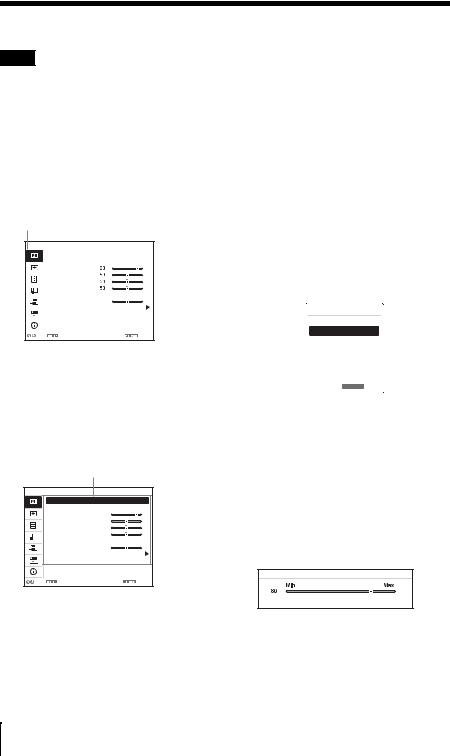
B Adjustments and Settings Using a Menu
Using a MENU
Note
The menu displays used for the explanation below may be different depending on the model you are using.
1 Press the MENU key to display the menu.
2 Select the setting menu.
Use the V/v key to select the setting menu then press the b key or ENTER key.
Setting menu
Picture
|
|
|
|
|
Picture Mode |
Standard |
|
|
|
|
|
Reset |
|
|
|
|
|
|
Contrast |
|
|
|
|
|
|
Brightness |
|
|
|
|
|
|
|
|
|
|
|
|
|
Color |
|
|
|
|
|
|
Hue |
|
|
|
|
|
|
Color Temp. |
Low |
|
|
|
|
|
Sharpness |
30 |
|
|
|
|
|
Expert Setting |
|
|
|
|
|
|
|
|
|
|
|
|
|
|
|
|
|
|
|
|
|
|
|
|
:Sel |
:Set |
:Back |
||
3 Select the setting item.
Use the V/v key to select the setting menu then press the b key or ENTER key.
To return to the selection screen of the setting menu, press the B or RETURN key.
Setting items
Picture
|
Picture Mode |
Standard |
|
Reset |
|
|
Contrast |
80 |
|
Brightness |
50 |
|
Color |
50 |
|
Hue |
50 |
|
Color Temp. |
Low |
|
Sharpness |
30 |
|
Expert Setting |
|
:Sel |
:Set |
:Back |
4 Make the setting or adjustment for the selected item.
The setting method varies, depending on the setting item.
If the next menu window is displayed, select the item according to the
operations in step 3 and then press the ENTER key to register the setting. To return to the selection screen of the
setting items, press the B or RETURN key. As an aid to setting or adjusting items, you can press the RESET key to return an item to its factory setting.
Using a pop-up menu
Press the V/v/B/b key to select an item. A selected item takes effect immediately, except “Language”, which will take effect after you press the ENTER key.
Picture Mode
Dynamic
Standard
Presentation
Blackboard
Game
Cinema
 :Sel RETURN :Back
:Sel RETURN :Back
Using the setting menu
Press the V/v key to select the item. A selected item takes effect immediately. The previous screen is restored.
Using the adjustment menu
To increase the value, press the V/b key and to decrease the number, press the v/B key. If you press the ENTER key, the selected item takes effect immediately. The previous screen is restored.
Contrast
 Adjust
Adjust  Back
Back
5 Press the MENU key to clear the menu.
The menu disappears automatically if no operation is performed.
14 Using a MENU
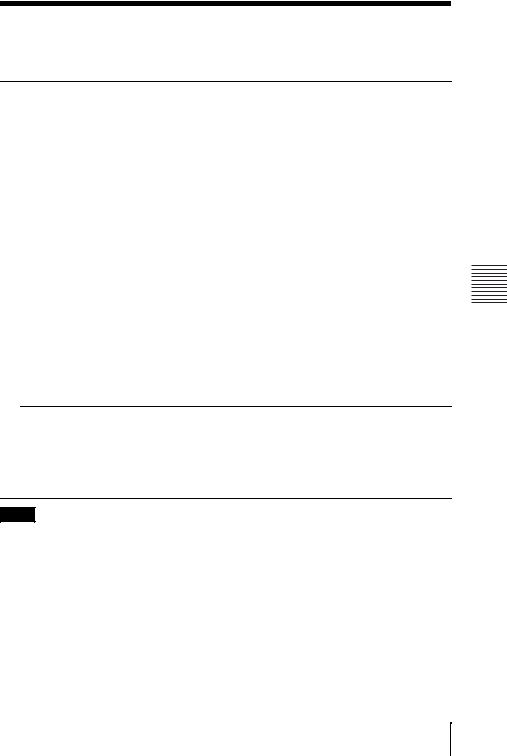
 The Picture Menu
The Picture Menu
The Picture is used to adjust the picture for each input signal.
Items |
Item descriptions |
Picture Mode |
Dynamic: Emphasizes the contrast to produce a dynamic and vivid picture. |
|
Standard: Provides an image which is natural and well balanced. |
|
Presentation*1: Provides a bright image, suitable for presentations. |
|
Blackboard: Provides an image suitable for displaying on a blackboard. |
|
Game: Provides an image suitable for viewing games. |
|
Cinema: Provides an image suitable for viewing movies. |
|
|
Reset*2 |
Resets to the factory setting. |
Contrast |
The higher the value, the greater the contrast. The lower the value, the lower |
|
the contrast. |
|
|
Brightness |
The higher the value, the brighter the picture. The lower the value, the darker |
|
the picture. |
|
|
Color*3 *4 |
The higher the value, the greater the intensity. The lower the value, the lower |
|
the intensity. |
|
|
Hue*3 *4 *5 |
The higher the value, the more greenish the picture becomes. The lower the |
|
value, the more reddish the picture becomes. |
|
|
Color Temp.*6 |
High/Middle/Low: The higher the value, the more bluish the picture |
|
becomes. The lower the value, the more reddish the picture becomes. |
|
|
Sharpness |
The higher the value, the sharper the picture becomes. The lower the value, the |
|
softer the picture becomes. |
|
|
Expert Setting |
|
Gamma
Mode*1 *7
Graphics 1: Gamma correction to make halftones brighter. This setting is suitable when projecting highly colorful images, such as photos, in a bright place.
Graphics 2: Gamma correction to improve the reproduction of halftones. Highly colorful images, such as photos, can be reproduced in natural tones. Text: Improves back and white contrast. Suitable for images with lots of text content.
Notes
*1: When a computer signal is input, this option is available.
*2: The settings in the Picture return to their factory defaults, except for Picture Mode. *3: When a video signal is input, this option is available.
*4: When the signal without color burst signal is input, this option is unavailable.
*5: When an analog TV signal is input, this option may not available, depending on the color system. *6: When “Picture Mode” is set to the item other than “Presentation” or “Blackboard,” this option
is available.
*7: When “Picture Mode” is set to “Blackboard,” this option is unavailable.
Menu a Using Settings and Adjustments
The Picture Menu 15
